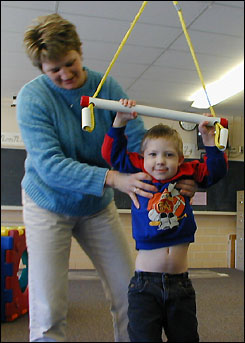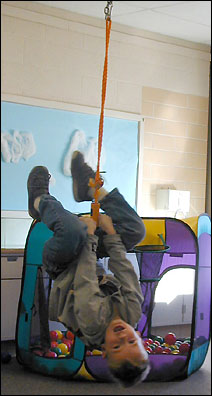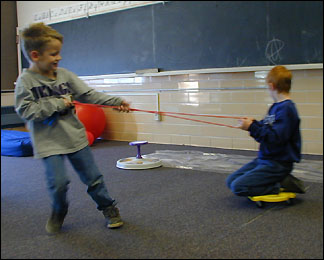Elementary offers kids room to S.M.I.L.E.
 Special needs children at Paynesville Area Elementary School (PAES) have a new reason to smile. This fall the Sensory Motor Integration Learning Environment, or S.M.I.L.E. room, opened to provide students who receive special education services with a place dedicated to re-energizing or calming them, according to their needs.
Special needs children at Paynesville Area Elementary School (PAES) have a new reason to smile. This fall the Sensory Motor Integration Learning Environment, or S.M.I.L.E. room, opened to provide students who receive special education services with a place dedicated to re-energizing or calming them, according to their needs.Filled with spots both for active play and quiet time, the room offers students a place to spend anywhere between three and 15 minutes recharging their sensory batteries before returning to their regular classes. "They can blow off steam here then return to their classes and learn in a healthier, more productive manner," said Sue Currens, a special education teacher at PAES.
Starting this year at PAES, students with sensory integration difficulties are able to take short breaks in the S.M.I.L.E. room. Holding the swing bar is pre-schooler Nicholas Schoenherr with special education teacher Sue Currens.
Occupational therapist and clinical psychologist Dr. A. Jean Ayers identified sensory integration disorders in nearly 70 percent of children with developmental or learning disabilities. "Students with autism spectrum disorders need stimulating activities," said Currens, "while kids with attention deficit disorders need calming ones."
Ayers' research states that children affected by sensory integration issues have difficulty organizing and interpreting information provided by their senses - sight, sound, touch, movement, body awareness, and the pull of gravity. In order to learn and behave in increasingly complex areas, children need an accurate sensory composite of both their physicality and environment.
 For most people, this occurs unconsciously, but for those with a sensory integrative disorder, the process becomes convoluted and extremely challenging. These skills usually mature by the age of eight to ten, but when the central nervous system isn't functioning correctly, the brain can't organize everyday input and sensations. In these cases, sensory integration therapies can provide further refinement to aid in creating a solid foundation for learning.
For most people, this occurs unconsciously, but for those with a sensory integrative disorder, the process becomes convoluted and extremely challenging. These skills usually mature by the age of eight to ten, but when the central nervous system isn't functioning correctly, the brain can't organize everyday input and sensations. In these cases, sensory integration therapies can provide further refinement to aid in creating a solid foundation for learning.
Kindergartner Emmit Bjork gets another perpective hanging upside down in the S.M.I.L.E. room. While students clearly enjoy playing, time spent on sensory activities also improves concentration and productivity in their regular classes.
In the past, special education teachers and aides have tried to help students on a smaller scale, but had to do so in empty rooms or hallways with the needed equipment often inaccessible, said Currens. With the current decline in enrollment at PAES, the school was finally able to provide a designated room for the sensory integration needs of their special education students.
The activities children take part in are guided by the students themselves. According to Sensory Integration International (www.sensoryint.com), the active involvement and motivation of the child plays a crucial role in the process. "Most children tend to seek out activities that provide sensory experiences most beneficial to them at that point in their development."
Issues with sensory integration aren't limited to children. It affects all age groups, intelligence levels, and crosses economic divides. The disorder is prevalent among those with autism, learning disabilities, and other developmental disorders. It's also found in those born prematurely, people with brain injuries, and those with stress or substance abuse problems.
Typical indicators include delays in speech, language, academic, or motor skills; being over or under sensitive to touch, sights, or sounds; difficulty calming themselves, often distracted or appearing clumsy, and social or emotional problems.
Currens was a longtime advocate for a dedicated S.M.I.L.E. room at PAES. Motivated by both a similar program at Rocori and by the mother of one of her students, the room came to fruition last summer with funding from the West Central Education District.
 Students receiving special education services can use the S.M.I.L.E. room under supervision for a range of self-calming activities: jumping on a mini-trampoline, riding a scooter board, swinging, spinning, listening to music, rocking, and shaping clay or play-dough. Currently ten students between the ages of four and ten have breaks scheduled daily in the S.M.I.L.E. room, with others using it as needed.
Students receiving special education services can use the S.M.I.L.E. room under supervision for a range of self-calming activities: jumping on a mini-trampoline, riding a scooter board, swinging, spinning, listening to music, rocking, and shaping clay or play-dough. Currently ten students between the ages of four and ten have breaks scheduled daily in the S.M.I.L.E. room, with others using it as needed.
Kindergartner Emmit Bjork pulls third grader Brandin Mackendanz on the scooter board in the S.M.I.L.E. room. Funded by the West Central Education District, the sensory integration room helps special needs students attain a higher level of focus and functioning in regular classes after taking short breaks throughout the school day.
Several of the elementary special education teachers and aides belong to a study group along with their counterparts in both middle and high school to share information and learn from each other. Though additional S.M.I.L.E. rooms are not yet in process, the study group has discussed the eventual need to create them at both PAMS and PAHS. "Several of the students in elementary school have autism," Currens said. "Eventually they will move to middle school and high school, and their sensory integration issues will still need to be addressed."
Contact the author at editor@paynesvillepress.com • Return to News Menu
Home | Marketplace | Community